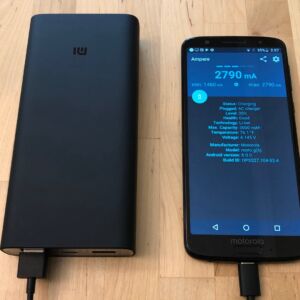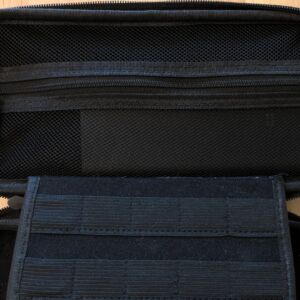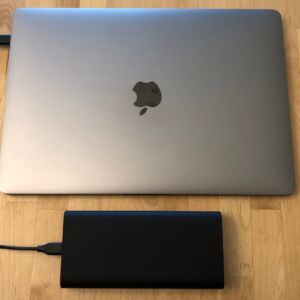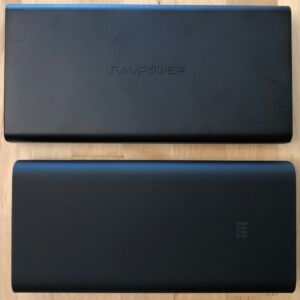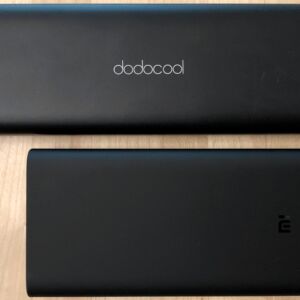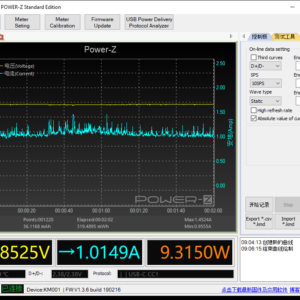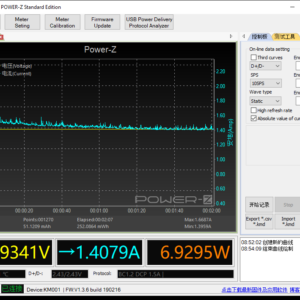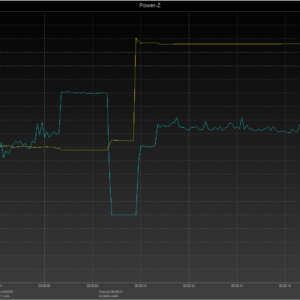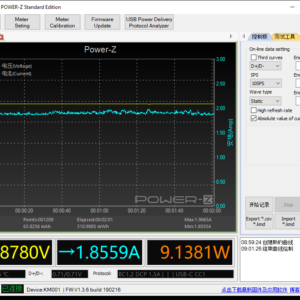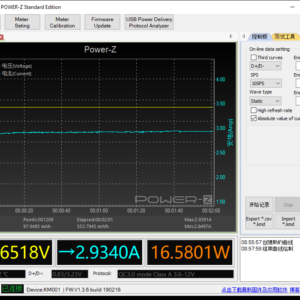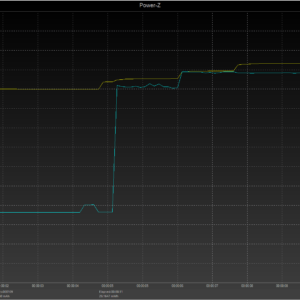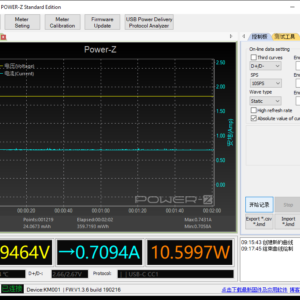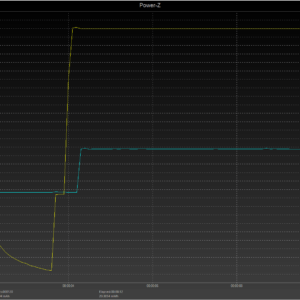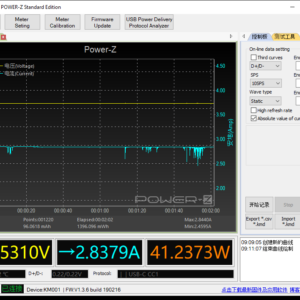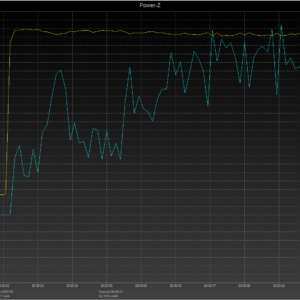Xiaomi Mi Power Bank 3 - Capable of fast charging most any device you connect to it
Summary
The Xiaomi Mi Power Bank 3 is one of a series of popular power banks globally. It supports a wide range of fast charging standards. But violates USB-C specs to do so.
Overall
-
Performance
(4.5)
-
Design
(5)
-
Safety
(4)
-
Recharge Time
(5)
User Review
( votes)Pros
- Fast charges iPhone, Samsung Galaxy, Google Pixel, LG, and Motorola phones
- Charges Switch in both handheld and TV mode
- Can be recharged by Nintendo Switch AC Adapter
- Fits in most Switch carrying cases
- Charges a 12 to 14-inch laptop
- PPS for supporting devices
- Supports lots of fast charging standards
- Supports pass through charging
- Charge two devices at once, but at reduced speeds
- Within FAA limits for lithium batteries and flights
Cons
- Can’t use USB-C PD and Quick Charge at the same time
- Quick Charge 3.0 and other fast charging tech over USB-C is against USB-C specs
- Limited to 40W for larger laptops
- Doesn’t include a USB-C to USB-C cable
Disclosure: As a Banggood affiliate I earn from qualifying purchases. Banggood provided the product in this review.
Available from:
Model: PLM07ZM
Tech Specs:
- Ports: USB-C, USB-A x2
- USB-C Output:
- 45W USB-C Power Delivery 3.0 (5V/3A, 9V/3A, 12V/3A, 15V/3A, 20V/2A)
- Programmable Power Supply (PPS) (5-11V/3A)
- Quick Charge 3.0
- Samsung Adaptive Fast Charging
- Huawei FCP
- Apple 2.4A
- USB-A Output:
- 18W Quick Charge 3.0
- Samsung Adaptive Fast Charging
- Huawei FCP
- Apple 2.4A
- Input: 45W USB-C PD (5V/3A, 9V/3A, 12V/3A, 15V/3A, 20V/2A)
- Capacity: 20,000mAh | 74 Wh
- Size: 6.1 x 2.9 x 1.1 inches | 154 x 74 x 28 mm
- Weight: 15.5 oz | 440 grams
Learn more about Fast Charging.
Included In Box:
- Xiaomi Mi Power Bank 3
- USB-C to USB-A 2.0 cable, 1 foot (56k Ohm resistor)
Good For:
- Commute
- Travel
- iPhone
- Android
- Nintendo Switch (handheld & docked)
- iPad Pro
- 12-inch laptop
- 13-inch/14-inch laptop
Estimated Number of Charges:
- iPhone 6/7/8: 7 charges
- iPhone Plus/X/XR: 4 charges
- Samsung Galaxy S8/S9: 4 charges
- Samsung Galaxy S10: 4 charges
- Nintendo Switch: 8.5+ hours of play
First Impression
The Xiaomi Mi Power Bank 3 is standard size, but an ounce heavier for a 20,000mAh/45W USB-C PD power bank. It curves at the edges but keeps the traditional rectangular shape. The two ends as glossy, making the ports and 4 LED indicators stand out. But also making the labels on the ports and specs on the back are difficult to read. The rest of the enclosure is matte black and smooth, except for the raised logo. It shares the Mi branding with Xiaomi’s phones. It would keep a single phone up and running for days. But with its size and capabilities, it is best used with several devices. The user manual is in Chinese. With only a few specs standing out using international (English) standards.
Compared With Similar Power Banks
| Charger | Xiaomi Mi Power Bank 3 | dodocool 20100 45W Type-C PD Review | RAVPower 45W Super-C 20100 | ZMI PowerPack 20000 Review |
| Ports | USB-C, USB-A x2 | USB-C, USB-A x2 | USB-C, USB-A, micro-USB | USB-C, USB-A x2 |
| Output | 45W USB-C PD Quick Charge 3.0 | 45W USB-C PD | 45W USB-C PD | 45W USB-C PD Quick Charge 3.0 |
| Capacity | 20,000mAh | 20,100mAh | 20,100mAh | 20,000mAh |
| Features | Pass Through Charging | Pass Through Charging | Pass Through Charging USB Hub |
|
| Cable | USB-C to USB-A cable | USB-C to USB-C cable | USB-C to USB-C cable | USB-C to USB-C cable |
| Dimensions | 6.1 x 2.9 x 1.1 in 15.5 oz | 7.4 x 2.6 x 0.9 in 17.1 oz | 6.3 x 3.1 x 0.9 in 14.1 oz | 6.3 × 3.2 × 0.8 in 14.3 oz |
| Price | $59.99 | No products found. | No products found. | Price not available |
Prices are from Amazon Product Advertising API, last updated on 2024-12-26.
You can see more USB-C power banks here.
Device Testing
Check with your device’s manufacturer to verify which charging standards it supports.
USB Power Delivery & Quick Charge 4+ Phones
- Apple iPhone 8/X/XR/XS
- Essential Phone
- Google Pixel
- LG ThinQ/V30
- Razer
- Samsung Galaxy S8/S9/S10
- Samsung Galaxy Note 8/9
- Xiaomi Mi 8/9
- ZTE Axon Pro 9/10
Using an iPhone 8 for testing we find USB PD phones will fast charge over the USB-C port. iPhones will need to use a USB-C to Lightning cable, not included. And Android phones will need a USB-C to USB-C cable, also not included.
For iPhones, the USB-A port supports Apple 2.4A. An older, but still functional fast-charging standard. Older iPhones (4-7) can fast charge using USB-A. Newer iPhones will charge ~15 minutes faster using USB-C.
Quick Charge 3.0 Phones
- HTC
- LG
- Motorola
- Nokia
- Samsung Galaxy
- Sony
- Xiaomi Mi 5/6
- ZTE
Using a Moto G6 for testing we see Quick Charge will fast charge over the USB-A port. Any QC supporting Android phone with USB-C can use the included micro-USB cable with a USB-C adapter. Or a regular USB-C to USB-A cable.
Quick Charge is also offered on the USB-C port. But the Moto only does normal charging. This is typical of Motorola phones when QC is offered over USB-C. Samsung Galaxy, LG, and other QC supporting Android phones would be expected to fast charge.
Nintendo Switch
The Nintendo Switch charges at its max rate, up to 18W. It’ll fast charge while you play. Its charge rate while sleeping is also normal. This charger can also power the Switch’s dock.
Learn more about charging the Switch.
USB-C Laptops
Using a 13-inch MacBook Pro for testing we can draw up to 41W from this charger. That’s expected, after accounting for efficiency loss. But it is operating at 15V when normally we would expect 20V. This is likely due to 20V only offering up to 40W. The MBP is using the 15V profile to be able to draw more power. Different laptops may behave differently. You cannot force the power to draw to either 15V or 20V.
Different model laptops have different power demands. But in general, a 45W charger can support 12-inch, 13-inch, and 14-inch laptops. It can power a larger laptop in a pinch. It will charge while sleeping. But may only extend runtime if used while the larger laptop is active.
Programmable Power Supply
Programmable power supply (PPS) protocol was added in USB Power Delivery 3.0. But not all PD 3.0 devices and chargers support it. In fact, it is uncommon now but will grow in use. It allows for small, step-wise changes in voltage and current. This reduces conversion loss during charging. The power transfer is more efficient and lithium batteries endure less heat.
Under PPS charging occurs in two phases. In the first phase, the current (amps) is constant, with a gradual increase in voltage. In the second phase, the voltage (now at a higher state) is constant, with a gradual decrease in current.
Devices that support PPS include:
- LG G7/G8 ThinQ
- LG V40/V50 ThinQ
- Razer Phone
- Samsung Galaxy S10 5G/A70
- Xiaomi Mi 8/9
Any device that supports Quick Charge 4+ will support PPS. If your phone was released in 2018 or later you can check its specs to see if PPS is supported.
If your devices don’t support PPS this tech will not affect the power bank’s performance. And with this model, you’ll be future-proofed for a future PPS device.
Quick Charge 3.0 Over USB-C
The presence of Quick Charge and other fast charging standards over USB-C is against USB-C specifications. Such chargers have been around for years without issue. But we don’t know what the future holds.
Under section 4.8.2 of USB-C specifications, a proprietary charging method cannot change the voltage of USB-C output (between 4.40V and 5.25V) in a manner not defined by USB methods. Quick Charge operates at higher than default voltages. And so goes against the specifications. USB Power Delivery is an open-source charging method. Created alongside USB-C, it is with specs even though it also increases the voltage. The big difference is USB PD uses communication lines to negotiate power transfer. While proprietary methods take over the data lines for their negotiation. They do so because legacy USB connections, such as USB-A, don’t have comm lines.
There is no known risk with running proprietary charging standards over USB-C. Manipulating the data lines does disrupt data transfers. But when plugging into a wall charger or power bank there is no data transfer anyway. A few USB-C engineers warn against using any USB-C chargers with third party standards. Their concern is unforeseen consequences. Future technology may prove to be incompatible with such configurations. And pulling out a charger several years from now with a new device could have a bad result.
I have not run into any issues with these fast charging standards on this or any other charger. But as it is a spec violation I want you to be informed. If you’re a stickler for meeting USB-C specifications this isn’t a good charger for you. If you’re more pragmatic it works fine and has no known issues.
Pass-Through Charging
Pass-through charging allows a portable charger to both charge itself and a connected device. The power received from the wall charger splits. Some to the portable charger’s own batteries. And some to the connected device. How it handles the split varies. And there are more inefficiencies than normal.
This portable charger supports pass-through charging under these connections:
- Input: USB-C, Output: USB-A
Pass-through charging is useful when you only have one USB wall charger. But it is not recommended to use this feature regularly. It puts more heat and stress on the portable charger. Which will affect its lifespan. It can also provide an inefficient charge to your device. Again, not great for its own battery’s lifespan.
If you like to have the option when traveling, fine. But don’t set this up next to your bed at home every night.
Xiaomi Mi Power Bank 3 vs ZMI PowerPack 20000
The Xiaomi is partly responsible for my favorite power bank, the ZMI PowerPack 20000. When the Mi Power Bank 3 was announced it looked like an updated version of the ZMI PowerPack 20000. And in some ways it is. But the ZMI maintains some advantages.
Similarities
- USB-C x1, USB-A x2
- 20,000mAh capacity
- Up to 45W USB-C PD output (with 40W limit @ 20V)
- Quick Charge 3.0, Samsung AFC, Huawei FCP, and Apple 2.4A
- Charges Switch as fast as possible in handheld mode
- Can power a docked Switch
Differences
- Xiaomi supports Power Delivery 3.0, ZMI supports Power Delivery 2.0
- Xiaomi supports PPS
- Xiaomi is more efficient, up to 30 minutes more playtime
- ZMI supports USB Hub function (connect USB-A devices to ZMI, they appear on connected USB-C laptop)
- ZMI includes USB-C to USB-C cable and pouch
- ZMI is smaller and lighter
- ZMI costs $10 more, but Xiaomi loses that savings when you buy a separate USB-C cable
- ZMI is available on Amazon in the USA and a few other regions
- Xiaomi is available on Banggood in China, but ships worldwide
So which should you look at getting? If you like the USB hub function (one less USB-C adapter to carry around) then go with the ZMI. Or go with the ZMI if you want fast shipping from within the USA.
If the shipping time isn’t a factor the Xiaomi is more future proof with Power Delivery 3.0 and PPS support. And most any region can order the Xiaomi from China. Whereas the ZMI has limited availability outside of North America.
Summary
The Xiaomi Mi Power Bank 3 offers as many fast charging standards as possible in one package. It isn’t available from USA retailers. But it can ship to the USA at a competitive cost. Those outside the USA with fewer options can also enjoy international shipping.
For most model phones it’ll support fast charging. Even with Huawei models. Newer iPhones work with USB-C, older iPhones with USB-A. Most Androids will fast charge with either port. Newer phones that support PPS will enjoy a more efficient charge. And put less wear on the power bank and their device’s battery.
The Nintendo Switch provides several full recharges without any downtime. You could play the most demanding games for a full day in handheld mode. Or power a Nintendo Switch dock in a remote location for a bit less time.
A 12-inch laptop can draw at its max rate. And most 13-inch/14-inch laptops can stay topped off while performing normal workloads. Or charge while asleep.
Almost every significant fast charging standard is on this power bank. It is missing Huawei SuperCharge and OnePlus Dash. But those technologies are so different they are completely incompatible with the rest.
Also, note you cannot fast charge two devices at once. With USB-C and USB-A in use, only USB-C provides fast charging. With all three ports in use, no device receives fast charging.
About Xiaomi
Xiaomi has U.S. based support (web, chat, email, phone). They are a large and well respected Chinese electronics company, most known in the USA for their smartphones and laptops. They helped found ZMI, their USA mobile power brand.
About Banggood
Banggood is a Chinese e-commerce retailer that focuses on gadgets and electronics. They ship worldwide, with warehouses in Australia, Europe, Hong Kong, and the United States. They receive significant traffic from the USA. But are better known in other countries. Shipping to the USA is free for orders of $50 or more. But takes 7-20 business days if not in a regional warehouse. Closer countries usually see faster shipping.
Banggood’s reps are aware of how Chinese retailers are viewed. And they are realistic about the challenges they all face. They have recommended using PayPal over a credit card for the added security and want customers to understand the longer ship times before they order.
Bottom Line
The Xiaomi Mi Power Bank 3 is powerful. Supporting every fast charging standard possible. Which is both convenient and a USB-C spec violation. Newer and older phones can enjoy fast charging. As well as USB-C devices up to mid-sized laptops. It’ll support a wide range of diverse brands and devices.
Buy if you:
- Need a single power bank that’ll meet almost any charging need
- Have a PPS supporting device
- Want to fast charge a Huawei phone on the go
Don’t buy if you:
- Are in the USA and want fast shipping
- Aren’t comfortable with the USB-C spec violation
Available from:
You’ll want a USB-C wall charger to quickly recharge this USB-C power bank. I recommend the ZMI PowerPlug Turbo. Its 45W USB-C PD is perfect for this power bank.
Enjoyed this review? Sign up for the Switch Chargers newsletter and get updates on future reviews and Nintendo Switch related deals.




